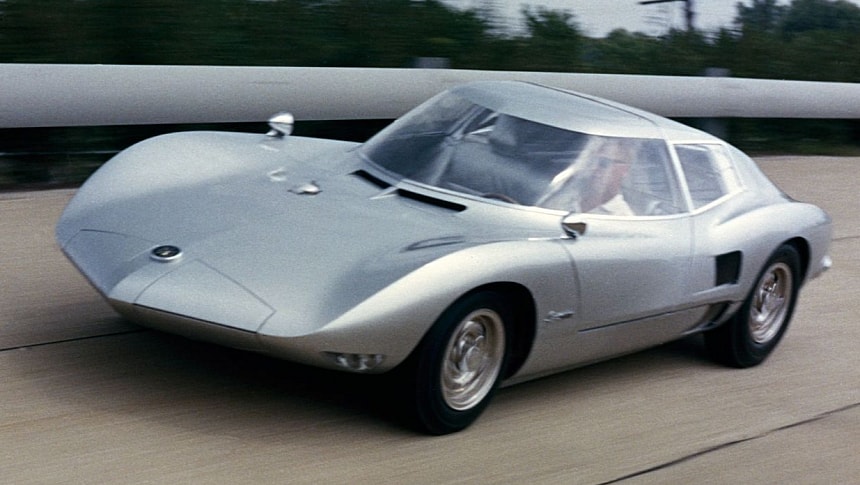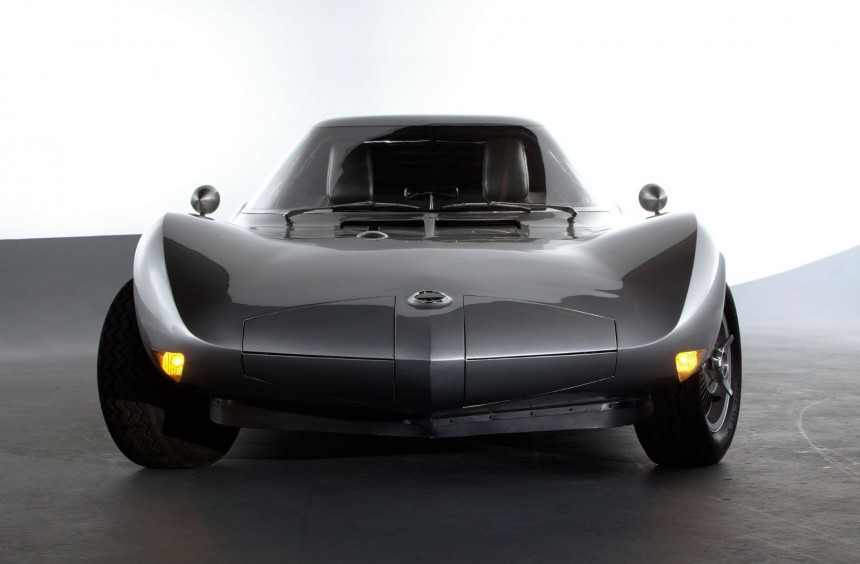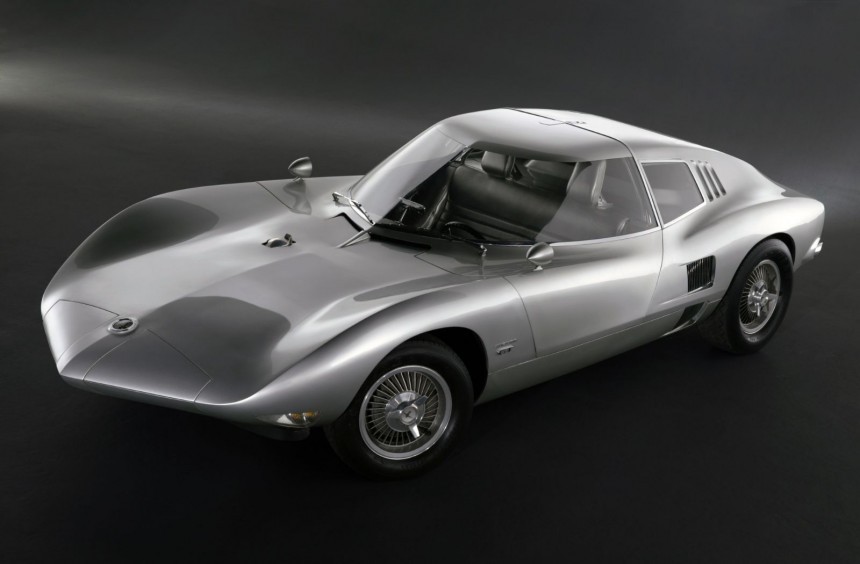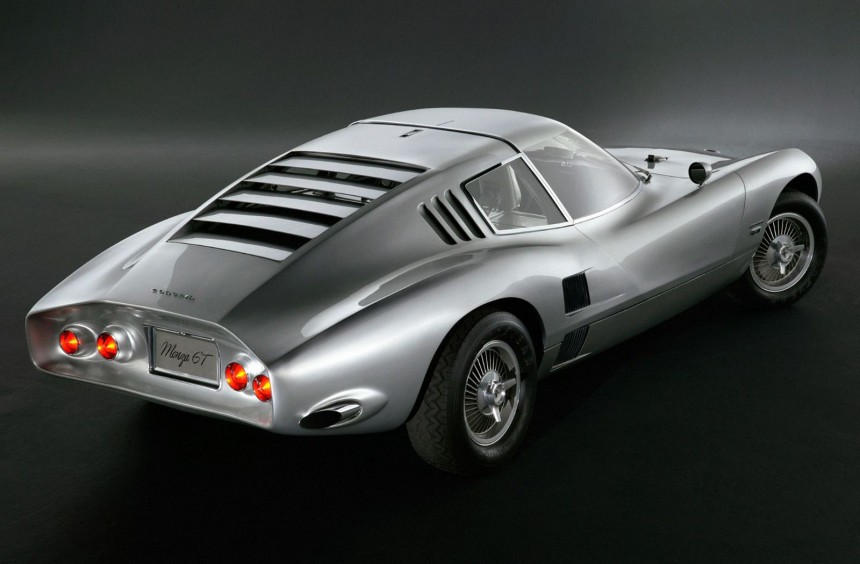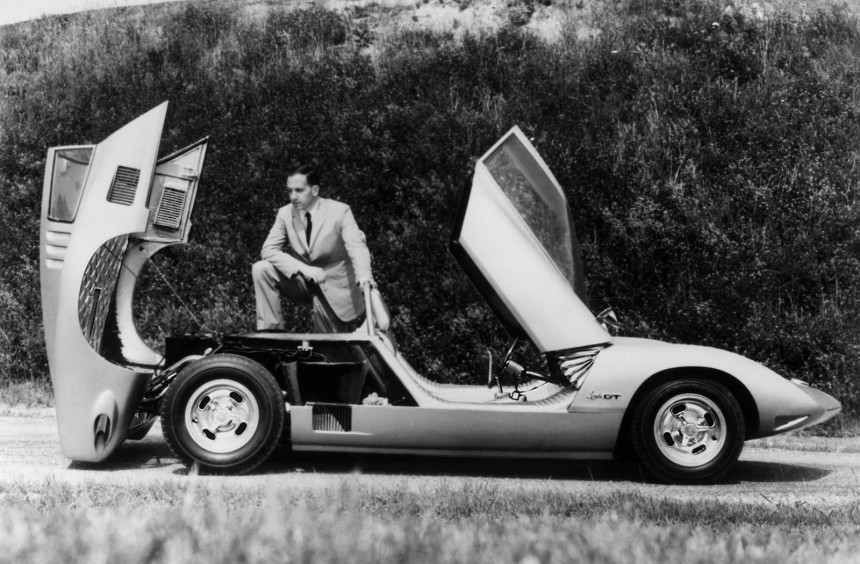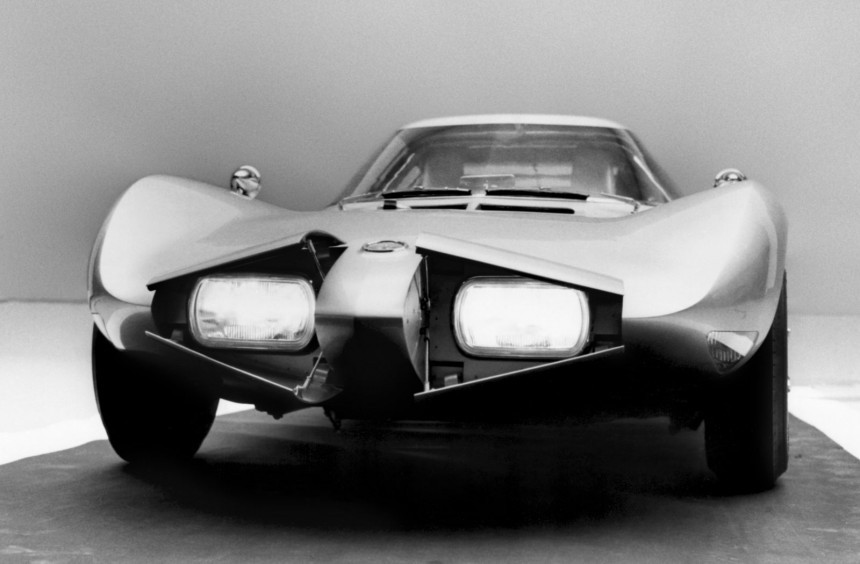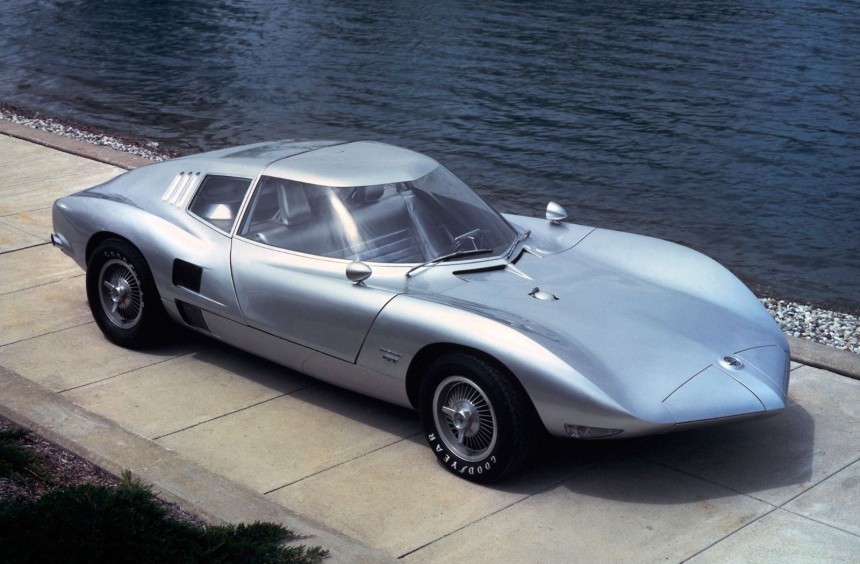While it was one of the most out-of-the-box passenger cars ever created by Chevy, the Corvair never became a Bowtie legend. However, its story could've been different had the mid-engine Monza GT made it past the concept stage.
A graduate of the General Motors Institute and an incurable car enthusiast, Ed Cole began making a name for himself within the GM engineering ranks in the late 1940s.
After co-developing the innovative Cadillac OHV V8, which subsequently inspired the creation of the Chevy small-block, Cole became chief engineer of the Chevrolet division in 1952.
Only four years later, he became Chevy's general manager, and under his supervision, the division's most creative minds (like Zora Arkus-Duntov, Bill Mitchell, or Larry Shinoda) were given the go-ahead to experiment with innovative designs and engineering solutions.
Cole was particularly fascinated by the transaxle, a component that combines the gearbox, differential, and axle into a single unit.
Employing a transaxle would've eliminated the bulky transmission tunnel, which, in turn, would enable the design of roomier cabins.
Cole envisioned a future where all Chevy models would use a transaxle and called this innovative line of vehicles Q-Chevrolets. However, despite numerous intriguing concepts, only one Q-Chevy made it into large-scale production: the Corvair.
Introduced in late 1959 as a 1960 model, the Corvair became Chevy's answer to the increasingly popular Volkswagen Beetle and the division's most atypical model.
An affordable compact available in various body styles, the Corvair used Cole's beloved transaxle linked to a rear-mounted, all-aluminum flat-six engine and came with a four-wheel independent suspension system.
Despite its econocar status, it was a pretty innovative model, particularly for 1960.
The model sold well during its first few years on the market, got an extensive redesign in 1965, and survived until 1969.
Today, the Corvair remains the only mass-produced Chevy to employ a flat-six and the second production car to feature a turbocharged engine behind the Oldsmobile Jetfire (introduced earlier in 1962).
Despite its innovative design, the Corvair was never a Chevrolet icon, but that could've changed if the fascinating Monza GT had made it into production.
While the mass-produced model line welcomed a sporty, turbocharged option for Monza coupes and convertibles in 1962, Chevy planned to take the notion of a sporty Corvair to another level with the Monza GT concept.
It all started with GM Vice President of Design Bill Mitchell's idea of transforming the Corvair into a legitimate sports car.
The plan was to create a breathtaking concept that would draw attention to the production model but also explore the feasibility of a Corvarir-based "baby Corvette."
Codenamed XP-777, the project was handed down to promising stylists Larry Shinoda and Tony Lapine, who were tasked with designing a radical new body, while a team led by Frank Winchell was instructed to build the modified chassis.
When Shinoda and Lapine were finished, the XP-777 (officially dubbed Corvair Monza GT) looked nothing like the mass-produced Corvair.
While the designers drew inspiration from other Corvair-based concept cars created by Italian coachbuilders Pininfarina and Bertone (the 1960 Corvair Speciale and upcoming 1963 Testudo), they took a fundamentally different approach.
A gorgeous mix of free-flowing curves and aggressive straight lines, the concept was way ahead of its time in terms of styling, which is why it's still impressive more than six decades later.
Resembling the Mako Shark II Corvette, a concept that would debut three years later, the redesigned Corvair's most intriguing visual features were the futuristic, forward-opening canopy top and the hidden "alligator style" headlights that became visible once the electronically-actuated split panels were opened.
While the canopy, with its pillarless curved windshield, was praised by everyone, the headlight design wasn't as eye-catching, yet it was an innovative approach nonetheless.
Overall, the concept car was unquestionably an unprecedentedly beautiful work of automotive art that inspired future GM concepts, like the Banshee XP-833, the Mako above Shark II and, consequently, the production version of the C3 Corvette.
Although the exterior design was (and still is) the main talking point, the Monza GT's underpinnings were also intriguing and innovative for the early 1960s.
Built around a modified Corvair chassis that was shortened by 16 inches (406 mm), the concept car featured a fully adjustable, double-wishbone independent suspension system and disc brakes on all four corners.
This was in stark contrast with the production Corvair's chassis, which had a less complex suspension (albeit also fully independent) and standard drum brakes throughout its lifespan.
Even more impressive, the Monza GT was a thoroughbred mid-engine sports car. Though it used a standard two-carb 145-ci (2.3-liter) Turbo-Air 6 rated at 102 hp, the unit was flipped so that it sat ahead of the transaxle for better weight distribution.
The Corvair Monza GT made its public debut in the summer of 1962 at Elkhart Lake, where it was met with excitement by the crowd and the motoring press.
Several months later, it took to the stage at the New York International Auto Show alongside a less futuristic, open-top version called Corvair Monza SS (Super Spyder).
Again, it drew a huge crowd and received extensive coverage, which prompted Chevy to consider developing a production version.
Though it was a thoroughly watered-down version of this concept, the production candidate codenamed XP-782 went well past the idea stage, but, unfortunately, declining interest in the Corvair range led to its abandonment.
Even though it remained a one-off concept car, the Corvair Monza GT lived on to inspire several GM projects and production cars.
Unlike other experimental cars from the 1960s, the GT was not destroyed or repurposed.
Instead, it joined the GM Heritage Center in Sterling Heights, Michigan, where it can be admired today, along with more than 700 legendary vehicles.
It's fair to say that the multitude of Corvette-based mid-engine concepts from the 1960s and 1970s are currently far more famous than the Monza GT. Nevertheless, this forgotten concept remains one of the most beautiful and intriguing Chevy ever created, even more than sixty years after its unveiling.
If you want to see more footage of this breathtaking one-off, we recommend the YouTube video below by Howard Cohen.
After co-developing the innovative Cadillac OHV V8, which subsequently inspired the creation of the Chevy small-block, Cole became chief engineer of the Chevrolet division in 1952.
Only four years later, he became Chevy's general manager, and under his supervision, the division's most creative minds (like Zora Arkus-Duntov, Bill Mitchell, or Larry Shinoda) were given the go-ahead to experiment with innovative designs and engineering solutions.
Cole was particularly fascinated by the transaxle, a component that combines the gearbox, differential, and axle into a single unit.
Employing a transaxle would've eliminated the bulky transmission tunnel, which, in turn, would enable the design of roomier cabins.
Cole envisioned a future where all Chevy models would use a transaxle and called this innovative line of vehicles Q-Chevrolets. However, despite numerous intriguing concepts, only one Q-Chevy made it into large-scale production: the Corvair.
A brief history of the Chevrolet Corvair
An affordable compact available in various body styles, the Corvair used Cole's beloved transaxle linked to a rear-mounted, all-aluminum flat-six engine and came with a four-wheel independent suspension system.
Despite its econocar status, it was a pretty innovative model, particularly for 1960.
The model sold well during its first few years on the market, got an extensive redesign in 1965, and survived until 1969.
Today, the Corvair remains the only mass-produced Chevy to employ a flat-six and the second production car to feature a turbocharged engine behind the Oldsmobile Jetfire (introduced earlier in 1962).
Despite its innovative design, the Corvair was never a Chevrolet icon, but that could've changed if the fascinating Monza GT had made it into production.
A sportier, much more appealing Corvair
It all started with GM Vice President of Design Bill Mitchell's idea of transforming the Corvair into a legitimate sports car.
The plan was to create a breathtaking concept that would draw attention to the production model but also explore the feasibility of a Corvarir-based "baby Corvette."
Codenamed XP-777, the project was handed down to promising stylists Larry Shinoda and Tony Lapine, who were tasked with designing a radical new body, while a team led by Frank Winchell was instructed to build the modified chassis.
A work of automotive art
While the designers drew inspiration from other Corvair-based concept cars created by Italian coachbuilders Pininfarina and Bertone (the 1960 Corvair Speciale and upcoming 1963 Testudo), they took a fundamentally different approach.
A gorgeous mix of free-flowing curves and aggressive straight lines, the concept was way ahead of its time in terms of styling, which is why it's still impressive more than six decades later.
Resembling the Mako Shark II Corvette, a concept that would debut three years later, the redesigned Corvair's most intriguing visual features were the futuristic, forward-opening canopy top and the hidden "alligator style" headlights that became visible once the electronically-actuated split panels were opened.
While the canopy, with its pillarless curved windshield, was praised by everyone, the headlight design wasn't as eye-catching, yet it was an innovative approach nonetheless.
Overall, the concept car was unquestionably an unprecedentedly beautiful work of automotive art that inspired future GM concepts, like the Banshee XP-833, the Mako above Shark II and, consequently, the production version of the C3 Corvette.
Mid-engine flat-six power
Built around a modified Corvair chassis that was shortened by 16 inches (406 mm), the concept car featured a fully adjustable, double-wishbone independent suspension system and disc brakes on all four corners.
This was in stark contrast with the production Corvair's chassis, which had a less complex suspension (albeit also fully independent) and standard drum brakes throughout its lifespan.
Even more impressive, the Monza GT was a thoroughbred mid-engine sports car. Though it used a standard two-carb 145-ci (2.3-liter) Turbo-Air 6 rated at 102 hp, the unit was flipped so that it sat ahead of the transaxle for better weight distribution.
A successful debut followed by plans for production
Several months later, it took to the stage at the New York International Auto Show alongside a less futuristic, open-top version called Corvair Monza SS (Super Spyder).
Again, it drew a huge crowd and received extensive coverage, which prompted Chevy to consider developing a production version.
Though it was a thoroughly watered-down version of this concept, the production candidate codenamed XP-782 went well past the idea stage, but, unfortunately, declining interest in the Corvair range led to its abandonment.
It's still around today
Unlike other experimental cars from the 1960s, the GT was not destroyed or repurposed.
Instead, it joined the GM Heritage Center in Sterling Heights, Michigan, where it can be admired today, along with more than 700 legendary vehicles.
It's fair to say that the multitude of Corvette-based mid-engine concepts from the 1960s and 1970s are currently far more famous than the Monza GT. Nevertheless, this forgotten concept remains one of the most beautiful and intriguing Chevy ever created, even more than sixty years after its unveiling.
If you want to see more footage of this breathtaking one-off, we recommend the YouTube video below by Howard Cohen.
